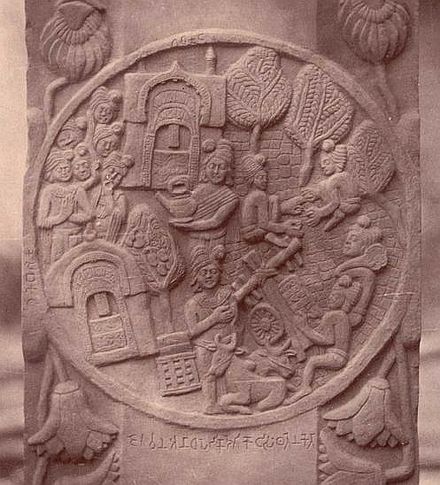Setthi


Setthi (Pali, seṭṭhi, Brahmi script: 𑀲𑁂𑀢𑁆𑀣𑀺) is a Pali word, often used in Buddhist scriptures and inscriptions, meaning a "foreman of a guild, treasurer, banker, 'City man', wealthy merchant" or "millionaire".[1]
Anathapindika, the main patron of the Buddha, was often referred to as Anathapindika-setthi, meaning Anathapindika, the wealthy one or the millionaire.[2]
The setthi Bhutapala, from Vaijayanti, one of the main patrons of the Karla Caves, left an inscription among the sculpted decorations on the veranda of the Chaitya, mentioning his completion of the cave.[3][4] The completion of the cave mentioned by Bhutapala may refer to the ornate sculptures of the veranda, during the final phase of decoration.[5]
References
- ^ "Setthi, Seṭṭhi: definitions". www.wisdomlib.org. 29 August 2010.
- ^ Dhammika, Shravasti (2005-12-01). The Buddha and His Disciples. Buddhist Publication Society. p. 64. ISBN 978-955-24-0280-7.
- ^ Senart, A. EPIGRAPHIA INDICA VOL 7 (in Portuguese). MANAGER OF PUBLICATIONS, DELHI. pp. 48–49.
- ^ Barrett, Douglas E. (1958). A Guide to the Karla Caves. Bhulabhai Memorial Institute. p. 8.
- ^ "the claim of Bhutapala, the merchant (sethi) from Vejayanti, that he completed this stone mansion, the finest in all of India (jambudipamhi utamam selaghara parinithapitam), is intriguing. He makes this claim in an inscription at the left end of the veranda. It is possible that he refers to the many-storeyed mansion in relief on the walls of the veranda when he speaks of the finest selaghara in all of Jambudvipa; on the other hand, the word ghara has clearly been used by the carpenter Sami to indicate the chaitya as a whole. If Bhutapala's claim relates to the chaitya itself, it is probable that he arrived on the scene at the critical period when the chaitya was in its finishing stages, and helped to complete it with numerous small donations" Miller, Barbara Stoler (1992). The Powers of Art: Patronage in Indian Culture. Oxford University Press. pp. 41–42. ISBN 978-0-19-562842-5.